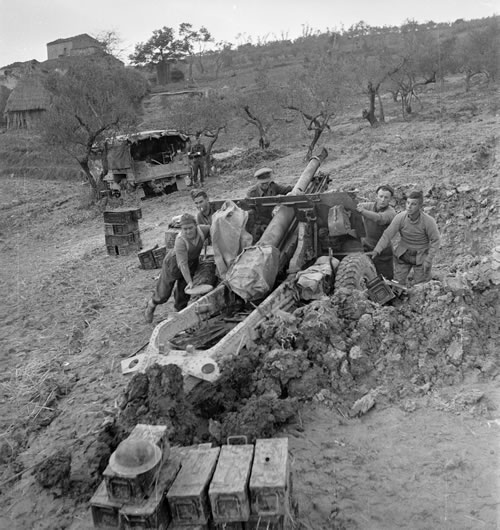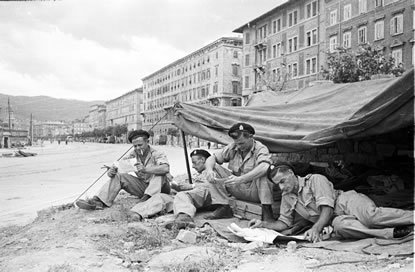Italian Campaign
Overview
Once the crucial political decision to send New Zealand troops to Italy had been made in Wellington in 1943, it ensured that the bulk of New Zealand's active soldiers would see action there until the end of war in Europe. While there, they would fight as part of General Sir Bernard Montgomery's multinational 8th Army, with which they had also been associated in the desert campaigns. For the New Zealanders of the Second Division, though, the only general who really mattered was their own commander, Lieutenant-General Bernard Freyberg. 'Tiny' Freyberg was an able, energetic leader who held the hard-won respect of his men, in part because of his well-known concern for their well-being and his aversion to casualties.
The force which Freyberg would lead in Italy had been seasoned by two years of active warfare. With a strong sense of camaraderie forged in the heat of battle, New Zealand 's predominantly amateur soldiers had transformed themselves into the 'Div'—a formidable fighting force, with a reputation for quiet but dogged efficiency. They had definitely acquitted themselves well in the deserts of North Africa where they had fought since 1942 after disheartening defeats and decampment from Greece and Crete. But they were not necessarily prepared for the conditions which they would encounter on the other side of the Mediterranean Sea.
Accordingly, after the decision was made to commit the New Zealand force to Italy, its members were allowed a period of recuperation and some months to reorganise in Egypt. Many of those who had served longest were permitted a furlough back home and the Second Division was strengthened with reinforcements from New Zealand before setting off for Italy in October 1943. The new arrivals were fresh, but they were untested in battle and had yet to be integrated into the ways of the 'Div'. Moreover, the seasoned soldiers who remained were as battle weary as they were battle hardened. Their first port of call was Taranto before they moved on to assemble in Bari, which would serve thereafter as the main staging base for New Zealand troops arriving in Italy.
Into action at the Sangro River
The 'Div' was soon in action at the end of November. The New Zealanders were assigned the task of joining the Allied effort to breach the Gustav Line by attacking its eastern margins and traversing the Sangro River with the hope of initiating an advance to Rome.

Winching a gun into a new position on the Sangro River front.
Alexander Turnbull Library, War History Collection, DA-04694
They made good initial progress, suffering about 150 casualties, but capturing several hundred Germans and skilfully using Bailey bridges to ford the Sangro—one of a seemingly endless succession of rivers they would traverse in their long advance up the Italian peninsula. On 2 December, the 'Div' had secured the village of Castelfrentano—a place name memorialised in a popular song of the Italian campaign. They moved on to attack the town of Orsogna and it even seemed possible that they would break the Gustav Line. Although New Zealand infantry actually entered the town on 3 December, they were repulsed by German reinforcements, bolstered by tanks. Despite repeated attacks in the succeeding weeks, the Germans proved immovable. With winter deepening, the whole Allied offensive ground to a halt and spirits were low amongst the New Zealanders when they were finally withdrawn from the stalled front line in January 1944 after suffering some 1600 casualties during their first two months of combat in Italy.
Cassino
The Division was to enjoy only a brief respite before being called upon to participate in a new attack on a strong point which would prove the most tragically elusive prize of the entire campaign for the New Zealanders. They now marched across to the other side of Italy to join the Allied forces massing before the town of Cassino.
The Germans' success in blunting the Allied offensive prompted an effort to push through the strategically pivotal Liri Valley and on to Rome. The problem was that the entrance to the valley was just over ten kilometres wide and was overlooked by the 500-metre high monastery of Monte Cassino. Augmented by the Germans' meticulous deployment of minefields, fortifications and flooding though demolition of stop-banks, Cassino was a defender's dream and an attacking army's nightmare. New Zealand involvement in this challenging task was in part due to the failure of the American 5 Army's attack on Anzio in a sea-borne attack intended to by-pass the German front line.
Temporarily heading a New Zealand Corps bolstered by the inclusion of the 4 Indian Division, Freyberg now steeled himself and his forces for the battle ahead. Desperate to minimise casualties, he requested a massive bombardment of the German defences to precede the assault by his troops. Approved by the Supreme Allied Commander in the Mediterranean himself, General Sir Harold Alexander, the subsequent aerial bombardment on 15 February laid waste the historic monastery and its environs. Controversy about this decision would persist long after the war was over. Tragically for the waiting New Zealand soldiers, most of the German defenders survived and exploited the ruins to create an even more formidable set of defences.
They nevertheless proceeded with the plan, which involved the Indian Division attacking Cassino from the north, while the New Zealanders were to attack the town from the south with the hope of punching an opening for the Allies into the Liri Valley. It fell to the 28 (Maori) Battalion to initiate the attack on the town's well-defended railway station on 17 February.
After one of the fiercest and costliest battles in the annals of this legendary unit, the Maoris seized positions in and around the station. But the equally courageous engineers behind them were thwarted in their efforts to clear a path through the flooded terrain for reinforcements. Without that much needed support the isolated Maori soldiers were forced to withdraw after a withering counter-attack by German infantry backed by tanks. It was the first of numerous bitter disappointments for the New Zealanders at Cassino.
A series of other brave but unsuccessful assaults ensued. After another heavy bombardment, New Zealand forces fought their way into the devastated town on 15 March. Once again, the Germans put up tenacious resistance from hidden positions in the maze of rubble that was once Cassino. After eight days of fighting, Freyberg decided the cost was proving too high and he ordered his troops to cease seeking to advance. Shortly afterwards in early April, the New Zealand Division withdrew from the Cassino area, having suffered almost 350 deaths and many more wounded.

Devastation as the result of a shell blast near Cassino, March 1944.
Alexander Turnbull Library, War History Collection, DA-14039
Cassino did not eventually fall until May 1944 to British and Polish troops, with support from New Zealand artillery. The Gustav Line was finally breached. Allied forces entered Rome on 4 June, two days before D-Day. The success of the cross-channel invasion meant that the Italian campaign became an undeniably secondary theatre of operations, with seven Allied divisions redeployed to France in August 1944. The Italian campaign's main purpose was now to divert part of the German war effort and to tie down forces which might otherwise have been used to defend France and Germany itself.
North to Florence
After a period of rest and recuperation, the 'Div' was back in action again in July as part of the Allied effort to breach the Germans' new so-called Gothic Line running from Pisa to Rimini in the northern Apennines. The New Zealanders enjoyed early success in their return to the battlefield, capturing the town of Arezzo on 16 July. Seeking to move on to Florence, they encountered solid German resistance but eventually reached the city on 4 August. The New Zealanders were back in the line the following month, fighting their way across difficult terrain in a slow advance which brought them to the Savio River by the end of October. They now had a month's break during which the Division was reorganised.
Faenza and the Senio River
They rejoined the attack in late November and succeeded in capturing Faenza on 14 December. Having reached the Senio River, the Division halted and endured its second Italian winter. After another period of relief, the 'Div' lined up again on the banks of the Senio River on 8 April to begin what would prove the final offensive in Italy. The New Zealanders now moved forward at an increasingly rapid pace. After crossing the Senio, the drive continued to the Santerno River and then on to the Gaiana River. Briefly halted there, the New Zealanders then pushed on to the Idice, finally crossing the Po river on Anzac Day 1945. Taking Padua on 28 April, the 'Div' embarked on its last helter-skelter advance, amidst disintegrating German resistance and partisan success everywhere.
To Trieste
The 'Div' crossed the Izonso River on 1 May and reached Trieste the next day just as the German forces in Italy surrendered unconditionally. After their exhilarating final charge covering over 220 kilometres in less than a week, the New Zealanders arrived just in time to share in the city's liberation with local partisans and units of Josip Tito's Fourth Yugoslav Army. It should have been a final moment of glory in the Italian campaign—a chance to savour the end of the war in Europe and relax before a speedy return home. Instead, it proved a 'helluva way to end a war', as one soldier recorded in his diary.

New Zealand soldiers camped close to one of the main streets, Trieste, May 1945.
Alexander Turnbull Library, War History Collection, DA-9389
The fortunes of war had pitched the 'Div' into an international hot spot, as Trieste became the setting for the first inter-Allied clash of the post-war era in Europe. The city was the focal point of a bitter territorial dispute between Italy and Yugoslavia. The Yugoslavs had hoped to strengthen their post-war claims to Trieste by being first to liberate it and then putting in place their own military administration. The Western Allies, however, had planned that the city should come under Allied Military Government like other parts of liberated Italy, pending a final peace settlement. By arriving in Trieste when they did, the Second Division dashed the Yugoslavs' hopes of presenting the Western Allies with a fait accompli. For some weeks, Trieste was under an uneasy dual occupation. Only after the problem was resolved diplomatically at the highest Allied levels were the New Zealand soldiers able to relax when the Yugoslavs reluctantly withdrew from the city in mid-June.
Home to New Zealand
The following month, the Division began moving to Lake Trasimene, from where most of the New Zealanders would began their long journey home. Limited availability of shipping meant that it would prove a slow process and it was not until February 1946 that the last members of the 'Div' ended their wartime Italian sojourn.
Roberto Rabel
From Megan Hutching (ed.), A Fair Sort of Battering: New Zealanders Remember the Italian Campaign, Auckland, HarperCollins NZ, 2004
Next: Timeline >